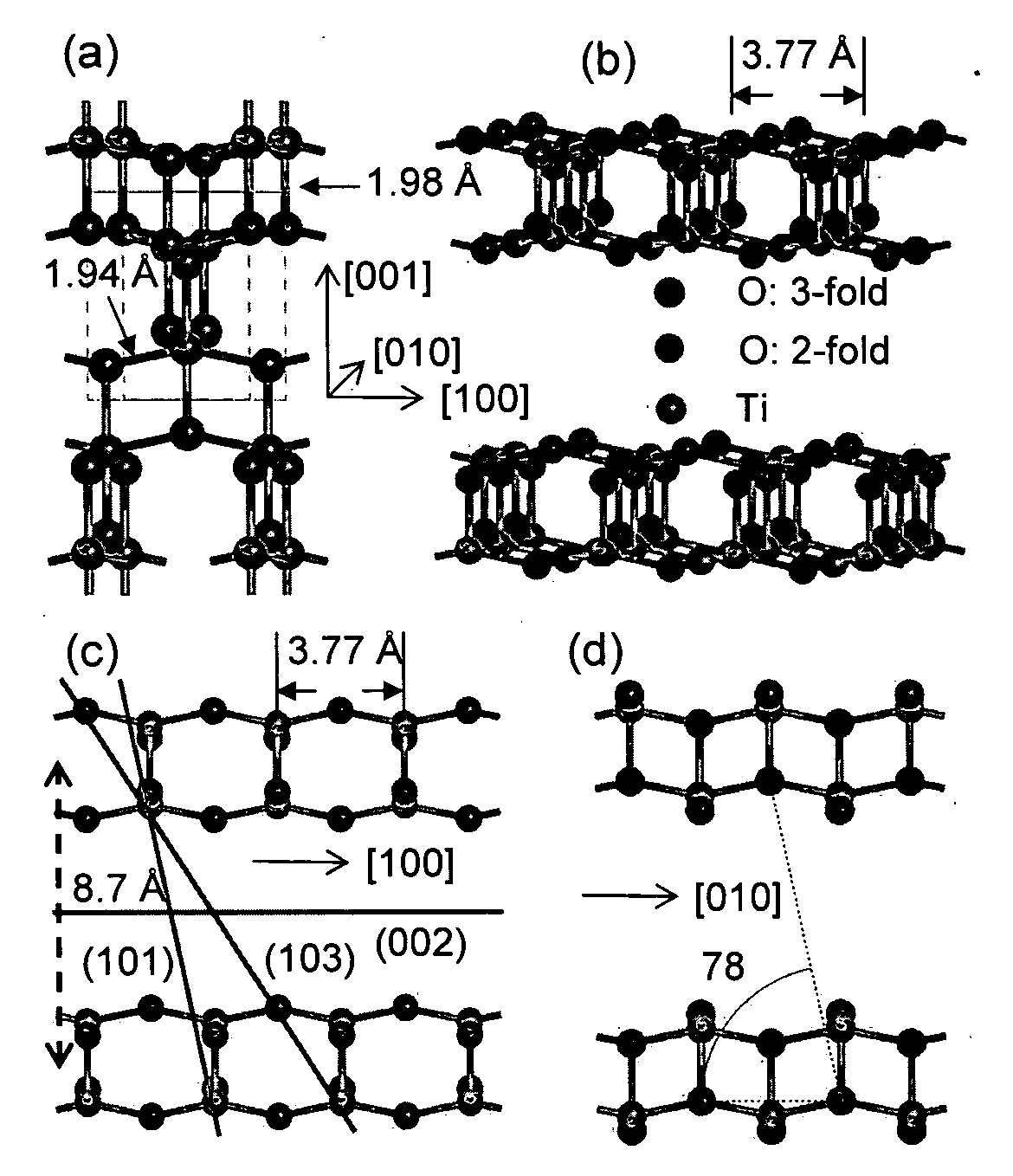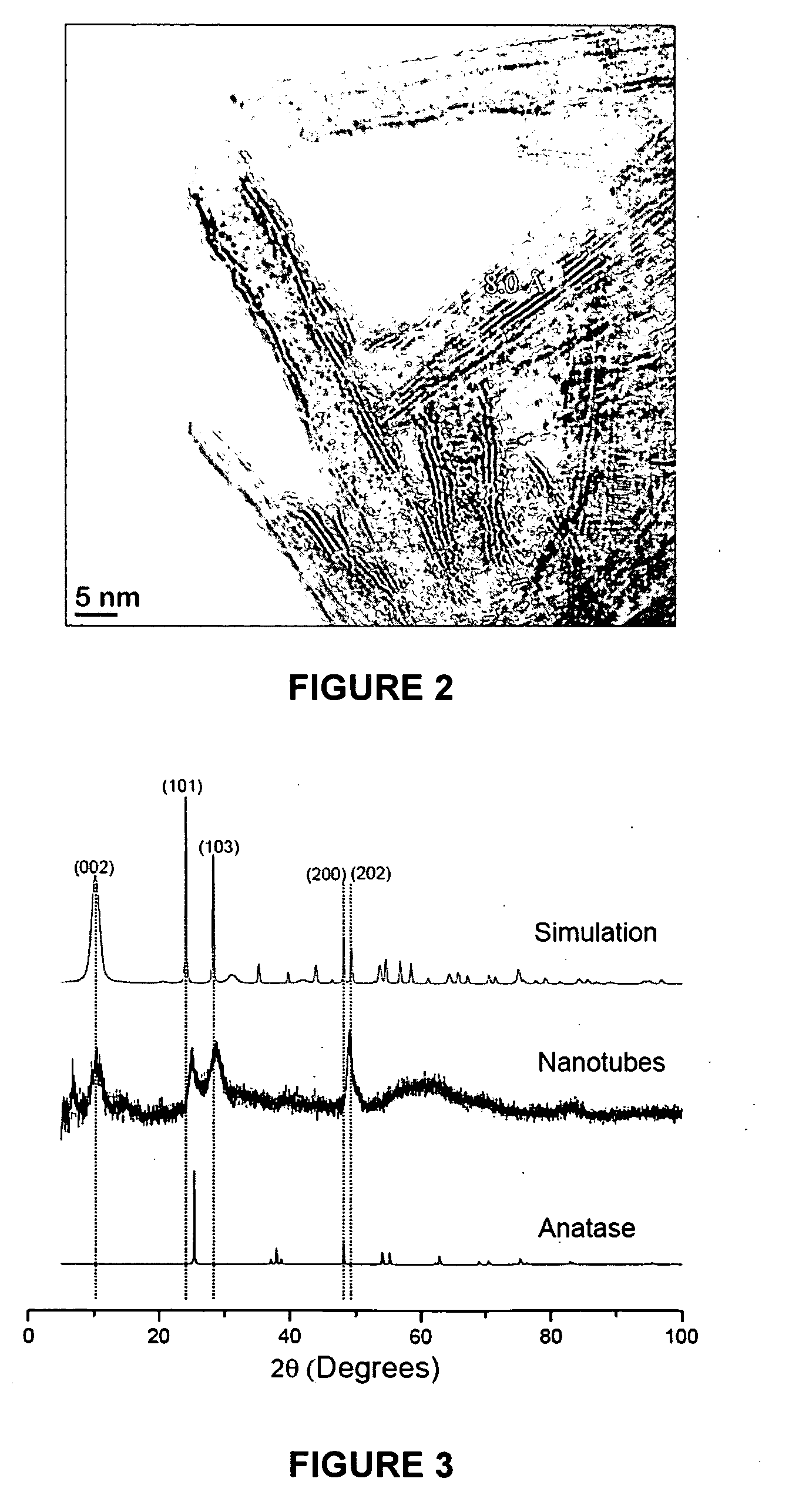Titania nanosheets derived from anatase delamination
- Summary
- Abstract
- Description
- Claims
- Application Information
AI Technical Summary
Problems solved by technology
Method used
Image
Examples
example 1
[0072]Nanotubes were synthesized from 32 nm anatase nanocrystals (Alfa Aesar, Ward Hill, Mass., USA) following the procedure described in Kleinhammes (Kleinhammes, A. et al., Chem. Phys. Lett. 411, 81-85 (2005)). 150 mg of synthesized nanotubes and 25 g of ZrO micro-beads were mixed together with 65 mL of distilled water in a Teflon grinding vessel. Grinding took place in a bead beater for 45 min at 100° C. At the conclusion of grinding, the ZrO beads sunk on the bottom and the top solution was transferred into centrifuge tubes using a pipette. The centrifuge tubes were sonicated for 15 min followed by centrifugation for 5 min at 4.4 k RPM. The top solution (least dense) contained the nanosheets. The top layer suspension was deposited on glass slides and dried at 50° C. TEM was performed on JEOL-100CX-II and HRTEM was done on JEOL-2010F (see, FIG. 4). UV-Vis was performed on Shimadzu ISR-3100 (see, FIGS. 6 and 7).
example 2
[0073]1H nuclear magnetic resonance (NMR) under magic angle spinning (MAS) at spinning rate of 20 kHz is employed to evaluate the state of adsorbed water. FIG. 5 shows the 1H NMR MAS spectra of nanosheets and nanotubes under various drying conditions. Two peaks are clearly resolved in as-synthesized nanosheet samples kept in a desiccator for 1 day, a broad low-field peak at 4.6 ppm and a narrow high-field peak at 1.2 ppm with LWHH of 1.1 ppm. The total number of protons measured is x=0.63 defined as TiO2.xH2O. Based on previous studies, the 1.2 ppm peak is associated with basic terminal hydroxyl Ti—OH and the broad peak at 4.6 ppm is typical of incorporated molecular water (Mastikhin, V. M., et al., Prog. NMR Spectrosc. 23, 259-299 (1991); Cracker, M. et al. J. Chem. Soc. Faraday Trans. 92, 2791-2798 (1996)). By drying the sample in the desiccator for 3 days, the 4.6 ppm peak is drastically reduced. The peak intensity of the 1.2 ppm peak is also reduced but at much smaller amount. D...
example 3
[0081]The major differences in the state of hydration between nanosheets and nanotubes also have a direct influence on their physical properties. FIG. 6 shows the UV-vis spectrum of anatase, nanotubes and nanosheets. Optical absorption is described by (αh v)n=A(hv−Eg) where α is the absorption coefficient, hv is the photo energy, and A is a constant. The value of n depends on whether the band gap is direct (n=2) or indirect (n=½). Data analysis shows that the UV-vis spectra of both nanotubes and nanosheets are described by n=2. FIG. 6 shows that the band gap Eg changes significantly from about 3.2 in anatase, to about 3.5 eV in nanotubes, and to about 4.0 eV in nanosheets.
[0082]Importantly, it can be seen that the band gap of the nanosheet material described herein is too large to absorb radiation in the visible range and as such, similar to other materials with large band gaps, dye molecules may be added to the materials to absorb visible radiation. Dye molecules contemplated inclu...
PUM
| Property | Measurement | Unit |
|---|---|---|
| Temperature | aaaaa | aaaaa |
| Temperature | aaaaa | aaaaa |
| Fraction | aaaaa | aaaaa |
Abstract
Description
Claims
Application Information
 Login to View More
Login to View More - R&D Engineer
- R&D Manager
- IP Professional
- Industry Leading Data Capabilities
- Powerful AI technology
- Patent DNA Extraction
Browse by: Latest US Patents, China's latest patents, Technical Efficacy Thesaurus, Application Domain, Technology Topic, Popular Technical Reports.
© 2024 PatSnap. All rights reserved.Legal|Privacy policy|Modern Slavery Act Transparency Statement|Sitemap|About US| Contact US: help@patsnap.com










